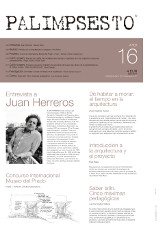Digital manufacturing. A theoretical and operational approach to the contemporary project
DOI:
https://doi.org/10.5821/palimpsesto.16.4873Keywords:
Project, theory, practice, representation, Craftwork.Abstract
The integration between design, representation and fabrication that digital technology allows, opens up new possibilities for the project. Thus simultaneous processes replace the traditionally sequential processes. This simultaneity can be linked to a pre-modern architectural conception. The CAD/CAM systems connect mind and hand, creation and production. This allows a collaborative working within the project, reshaping the author’s concept. The connection between craftwork and these new technologies permits to think of these technologies as a kind of digital manufacturing; capable of re-signifying the link between knowledge (software) and materialization (hardware), between theory and practice. In this context, the following research proposes a theoretical and operational discussion about the technological implications on architecture and its disciplinary development, considering also the challenges of contemporary reality.Downloads
Published
Issue
Section
License
PROTECTION AND INTELLECTUAL PROPERTY CRITERIA
Authors whose work is published in en Palimpsesto agree to the following terms:
1. The author retains the copyrights and guarantees the magazine the right to apply a Creative Commons Attribution-NonCommercial-NoDerivatives (CC BY-NC-ND), which permits others to share the work with acknowledgement of authorship.
2. The author may establish additional agreements of his or her own accord for non-exclusive distribution of the article published in the magazine (for example, in an institutional repository, or published in a book).
3. Electronic distribution of the work by the author(s) is permitted and encouraged (for example, in institutional repositories or on the author’s own website), prior to, and during the submission process, as this can generate productive exchanges, as well as earlier and greater citation of the published works (see The Effect of Open Access) (in English).
4. The author or provider of the material submitted for publication authorizes Palimpsesto to publish, with no obligation whatsoever (financial or otherwise) to the content of said material, be it in paper or digital format, or in any other medium.
5. The author or provider guarantees that he or she is the owner of the Intellectual Property rights to the contents provided, which encompasses the text and images/photographs/photographic works incorporated in the article.
6. The author or provider, exempts Palimpsesto magazine of all and any responsibility relating to violation of copyrights, thereby committing himself or herself to undertaking all efforts to assist Palimpsesto magazine in defence of any accusation, extra-judiciary, and/or judicial measures. Likewise, the author or provider will assume payment to Palimpsesto of any sum or compensation that must be paid to third parties for failure to comply with these obligations, be it the result of judicial, arbitrary or administrative decisions.
7. The submission of the texts by authors implies automatically a declaration of non plagiarism of its contents







